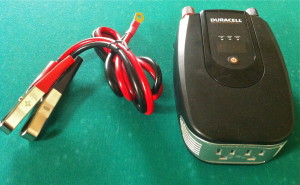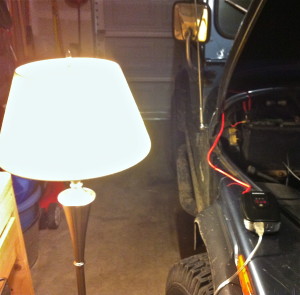- Do you live in an area where the power could ever go out?
- Do you own a vehicle (or, more accurately, own a vehicle battery)?
- Do you have small devices such as cell phones, laptop computers, tablet devices, power tools, or even lamps that you would like to be able to power during a blackout?
 If the answer to all these questions is “yes”, do yourself a favor and spend about $65 and get a Duracell Digital Inverter 800 (or another comparable quality inverter).
If the answer to all these questions is “yes”, do yourself a favor and spend about $65 and get a Duracell Digital Inverter 800 (or another comparable quality inverter).
How does an inverter work? To review, batteries store DC (direct current) power, while common household devices use AC (alternating current) power. An inverter converts stored DC power to useable AC power (anything with a two/three prong plug).
When people first begin thinking about backup power, they frequently discuss getting a generator. While a generator can be a good step — when it’s an informed decision, and it’s capabilities and limitations are understood. But a generator can be expensive, it takes up space, needs to be maintained, and storing gasoline for it can be a hassle. An easier first step to backup power is a quality inverter. If you already have a generator this adds a second level of redundancy, and might work even better for smaller devices and when you’re on the road.
I first heard about these inverters on The Survival Podcast in an interview with Steven Harris (here’s a list of the many interviews Steven has done on a variety of backup power topics).The Duracell Digital Inverter 800 is convenient and simple to use. It’s relatively compact (7.5” x 4.5” x 2.25”), solidly built, and light weight (1.8 pound). It has a nice LED digital display that shows input and output voltages, making it very easy to oversee and troubleshoot the inverter.
 To use, connect the inverter directly to your car’s battery terminals (using the DC battery cables with alligator clamps). Then, I’d recommend, run a long 14-gauge extension cord into your house and plug it into a power strip. Plug your devices into the power strip; when you’re not using it, you can turn off the power strip to ensure you’re not inadvertently drawing power to an appliance. Of course you can always plug appliances, or tools, directly into the inverter.
To use, connect the inverter directly to your car’s battery terminals (using the DC battery cables with alligator clamps). Then, I’d recommend, run a long 14-gauge extension cord into your house and plug it into a power strip. Plug your devices into the power strip; when you’re not using it, you can turn off the power strip to ensure you’re not inadvertently drawing power to an appliance. Of course you can always plug appliances, or tools, directly into the inverter.
When you’re using the inverter an alarm will sound when your car’s battery gets low, and the inverter will automatically shut off before the battery gets too low; this ensures you’ll never drain your vehicle’s battery further than you should. At that point you can either drive around for a bit, your car’s alternator will recharge your battery, or switch to another vehicle’s battery. For those that have a diesel pickup truck (like our Ford F350) you have TWO batteries, so twice the backup power potential. If you leave your vehicle idling, you can draw full power as long as you have available fuel; this is especially handy for larger devices (the inverter can handle devices that surge up to 1280W). The inverter also has a high voltage shutdown, an overload shutdown, and an overheating shutdown.
There are different size inverters, both higher and lower rated, but the 800 seems to fit the best for most of us. Their 400 is handy because it also comes with a DC lighter adapter allowing you to draw up to 150 watts without having to connect to the battery; very useful for road trips. (Despite what Amazon.com says, the 800 watt inverter does not come with a lighter adapter.)
Having an inverter will allow you–during a power outage, or anytime you’re away from an AC outlet (camping, job sites, etc.)–to convert the DC power stored in your car’s 12-volt battery into 120-volt AC power that you can plug electric devices into.
We tend to take electricity, and our access to it, for granted. When it’s not available our lifestyles quickly change. Having a Duracell Digital Inverter 800 around is an easy step to provide needed power for communication devices, tools, and light when needed.
